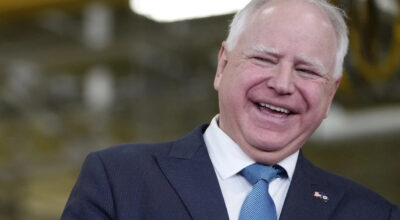Normandy commemorates D-Day with small crowds, but big heart
Published 12:00 am Monday, June 7, 2021
COLLEVILLE-SUR-MER, France (AP) — When the sun rises over Omaha Beach, revealing vast stretches of wet sand extending toward distant cliffs, one starts to grasp the immensity of the task faced by Allied soldiers on June 6, 1944, landing on the Nazi-occupied Normandy shore.
The 77th anniversary of D-Day was marked Sunday with several events to commemorate the decisive assault that led to the liberation of France and Western Europe from Nazi control, and honor those who fell.
“These are the men who enabled liberty to regain a foothold on the European continent, and who in the days and weeks that followed lifted the shackles of tyranny, hedgerow by Normandy hedgerow, mile by bloody mile,” Britain’s ambassador to France, Lord Edward Llewellyn, said at the inauguration of a new British monument to D-Day’s heroes.
On D-Day, more than 150,000 Allied troops landed on the beaches code-named Omaha, Utah, Juno, Sword and Gold, carried by 7,000 boats. This year on June 6, the beaches stood vast and nearly empty as the sun emerged, exactly 77 years since the dawn invasion.
For the second year in a row, anniversary commemorations are marked by virus travel restrictions that prevented veterans or families of fallen soldiers from the U.S., Britain, Canada and other Allied countries from making the trip to France. Only a few officials were allowed exceptions.
At the newly-built British Normandy Memorial near the village of Ver-sur-Mer, bagpipes played memorial tunes and warplanes zipped overhead trailing red-white-and-blue smoke. Socially distanced participants stood in awe at the solemnity and serenity of the site, providing a spectacular and poignant view over Gold Beach and the English Channel.
The new monument pays tribute to those under British command who died on D-Day and during the Battle of Normandy.
A text carved on the wall writes: “They died so that Europe might be free.”
Visitors stood to salute the more than 22,000 men and women, mostly British soldiers, whose names are etched on its stone columns. Giant screens showed D-Day veterans gathered simultaneously at Britain’s National Memorial Aboretum to watch the Normandy event remotely. Prince Charles, speaking via video link, expressed regret that he couldn’t attend in person.
On June 6, 1944, “In the heart of the mist that enveloped the Normandy Coast … was a lightning bolt of freedom,” French Defense Minister Florence Parly told the ceremony. “France does not forget. France is forever grateful.”
Charles Shay, a Penobscot Native American who landed as an U.S. army medic on June 6, 1944 and now calls Normandy home, was the only surviving D-Day veteran at the Ver-sur-Mer ceremony.
Another veteran of the Battle of Normandy, British Capt. David Mylchreest, was also present. He landed with his team in Normandy on June 12, 1944, to replace officers who had died in the first days of the fight.
Shay then took part in a commemoration at the American Cemetery later in the day in Colleville-sur-Mer, on a bluff overseeing Omaha Beach, in the presence of officials from the United States, Canada, Britain, Germany and other allied countries.
The cemetery contains 9,380 graves, most of them for servicemen who lost their lives in the D-Day landings and ensuing operations. Another 1,557 names are inscribed on the Walls of the Missing.
Most public events have been canceled, and the official ceremonies were limited to a small number of selected guests and dignitaries.
Denis van den Brink, a WWII expert working for the town of Carentan, site of a strategic battle near Utah Beach, acknowledged the “big loss, the big absence is all the veterans who couldn’t travel.”
“That really hurts us very much because they are all around 95, 100 years old, and we hope they’re going to last forever. But, you know…” he said.
“At least we remain in a certain spirit of commemoration, which is the most important,” he told The Associated Press.
Over the anniversary weekend, many local residents have come out to visit the monuments marking the key moments of the fight and show their gratitude to the soldiers. French World War II history enthusiasts, and a few travelers from neighboring European countries, could also be seen in jeeps and military vehicles on the small roads of Normandy.
Some reenactors came to Omaha Beach in the early hours of the day to pay tribute to those who fell that day, bringing flowers and American flags.
On D-Day, 4,414 Allied troops lost their lives, 2,501 of them Americans. More than 5,000 were wounded. On the German side, several thousand were killed or wounded.
Normandy has more than 20 military cemeteries holding mostly Americans, Germans, French, British, Canadians and Polish troops who took part in the historic battle.
Dignitaries stressed the importance of keeping D-Day’s legacy alive for future generations.
“In the face of the threats of today, we should act together and show unity,” Parly said, “so that the peace and freedom last.”



